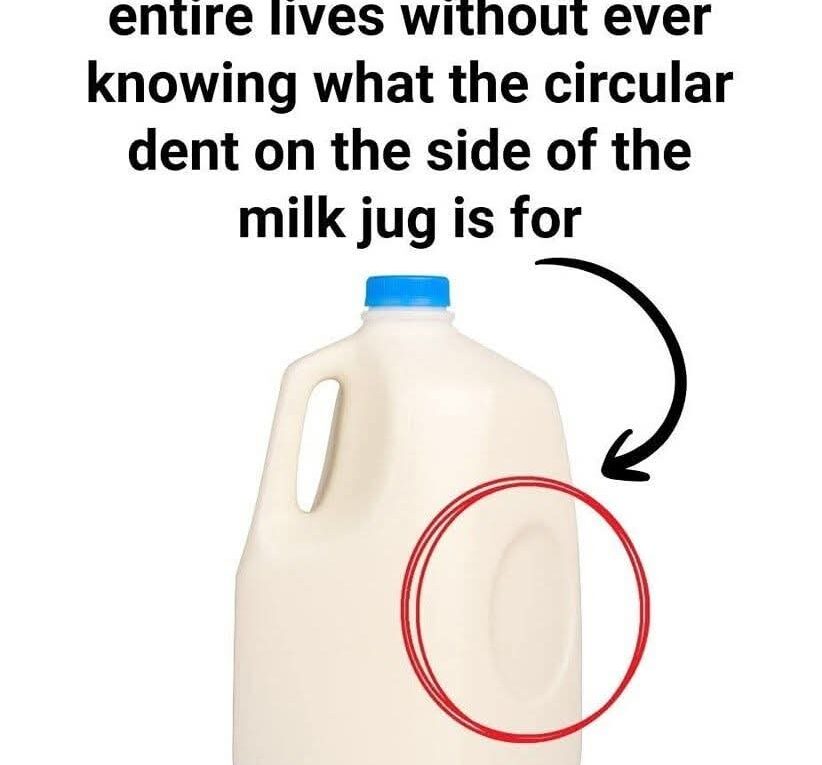Purpose of the Circular Dent on Milk Jugs
I’m going to own up to it — I have stared at that little mystery dent on the side of a milk jug more times than I can count. You know the one. Perfectly round, a little sunken in, sitting there like it knows a secret. And apparently, it does. If you’re anything like me (and most people), you probably took it to be some sort of quirk of the plastic molding process, or, perhaps, just… decorative? But nope. That circular dent has a job. A smart one.
So grab your cereal, pour some milk, and let’s dig into the curious case of the milk jug dent.
Why There’s a Round Dent in the Bottom of Milk Jugs
That circular dent on your milk jug isn’t some manufacturing mishap or cut corners in the design process. It’s there for a combination of safety, function, and structural integrity. Here’s the rundown:
Buffer for Expansion Due to Pressure Changes
Let’s begin with the most practical: pressure.
Milk, after all, is a perishable item, isn’t it? It has to be kept at cold temperatures. And like all liquids, milk expands or contracts a little when the temperature changes (for example, from a warm truck ride to a cold fridge). The round dent accommodates those temperature and pressure shifts with flexibility.
Without that little feature? The jug may swell outward, crack or in extreme cases even burst — particularly if it’s frozen. The dent gives an area that can bubble out a bit if required. It’s the milk jug’s ever-present stress ball.
Dampening Shock to Avoid Splits
Ever spilled a jug of milk on accident?
Yeah, me too. The dent also serves as a sort of shock absorber. When a jug falls to the floor (or even just gets abused at the grocery store), the recessed circle helps absorb and redistribute the impact energy.
That design reduces cracking and spillage — a godsend if you’ve ever had to clean up a milk puddle and know how messy and annoying that can be. And when margins are razor thin in industry, avoiding even a few cracked jugs during transport can equal real savings.
Retention of Structure Without Any Additional Plastic
Here’s something you weren’t expecting: the dent makes the jug more resilient using less plastic.
It’s like the ridges on a cardboard box, or the arch design in architecture. That indent provides structural support; it reinforces the side panel. Rather than thickening (and making more expensive) the plastic walls, they add the dent — to maintain strength while keeping the jug light.
This is good engineering on a budget. As if duct tape and geometry had a child.
All right, this one is a little bonkers.
Sometimes, if milk is beginning to spoil and the bacteria start to multiply, they can release gases that create pressure inside the jug. With that pressure in place, the dent will start to pop out.
So if you ever see a jug where the dent is puffed out or looks otherwise abnormal, don’t ignore it. That might be your milk crying out, “Hey! I’ve turned!” We know that not every dent bulge indicates bad milk, by the way, but it is a clever early warning system. And it’s certainly not an expectation for the average person

But Why This Specific Shape?
Why a circle, though? Why not a triangle or a square?
It turns out circles are inherently stronger shapes for distributing pressure. There are no sharp corners to focus stress. Instead, pressure transfers evenly around a circular edge, which is why it is the ideal shape for a flex-point in a jug that frequently encounters temperature shifts, handling and stacking.
From a manufacturing perspective, circles are also simple: They’re easy to mold and repeat hundreds of millions of times on identical containers. A tour de force of symmetry, simplicity, and science.
Other Hidden Design Details of Milk Jugs
While we’re nerding out over jug design, here are a few more things you likely never noticed:
The handle hole isn’t only for grip — the hole also minimizes the amount of plastic used in the design, without a loss of function.
Those little bumps at the base help the jug balance, even on somewhat wonky shelves.
Cap color can sometimes indicate fat content — blue for 2 percent, red for whole, etc. — depending on the brand and region.
It’s kind of remarkable how much care goes into something we all take for granted.

Easier recycling
Transportation with lower weight (which translates to fuel savings)In other words, the dent isn’t only clever — it’s a low-key eco-warrior doing its bit. An itsy bitsy champion in the war on waste.Next Time You Pour a Glass…Just consider: this little design element that you’ve probably overlooked your entire life is doing double time to:Keep your milk fresh
Protect against leaks
Reduce environmental impact
Prevent the dairy industry from losing billionsWild stuff for something you never gave a second glance, huh?The circular dent is the unsung background character of your morning. Always there. Quietly doing its job. Never asking for recognition. Just saving your fridge (and floor) from disaster.
 source: The Hand Prop Room
source: The Hand Prop RoomNow, I’m not saying you’re going to win a trivia contest with that little nugget, but when you next reach for a jug and catch that little dent in the side, tip it a nod. It’s not some random dimple. It’s engineering genius cast into plastic.And hey — if you ever find yourself at a party where the conversation dries up, just slip in the words “Did you know the dent in a milk jug can be used to detect spoilage?” Instant attention. You’re welcome.
